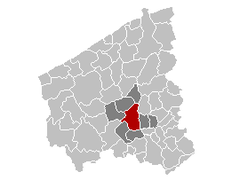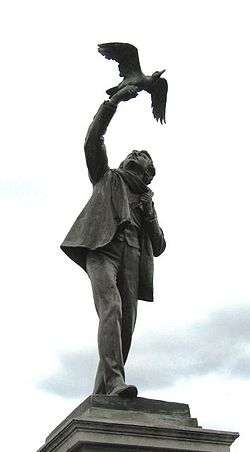Roeselare
Roeselare (Dutch pronunciation: [ˈrusəlaːrə], French: Roulers, West Flemish: Roeseloare) is a Belgian city and municipality in the Flemish province of West Flanders. The municipality comprises the city of Roeselare proper and the towns of Beveren, Oekene and Rumbeke.
Roeselare | |
|---|---|
.jpg) Town hall with belfry | |
 Flag  Coat of arms | |
 Roeselare Location in Belgium
Location of Roeselare in West Flanders  | |
| Coordinates: 50°56′N 03°07′E | |
| Country | Belgium |
| Community | Flemish Community |
| Region | Flemish Region |
| Province | West Flanders |
| Arrondissement | Roeselare |
| Government | |
| • Mayor | Kris Declercq (CD&V) |
| • Governing party/ies | CD&V, sp.a, Groen |
| Area | |
| • Total | 59.79 km2 (23.09 sq mi) |
| Population (2018-01-01)[1] | |
| • Total | 62,301 |
| • Density | 1,000/km2 (2,700/sq mi) |
| Postal codes | 8800 |
| Area codes | 051 |
| Website | www.roeselare.be |
The name of the city is derived from two Germanic words meaning "reed" and "open space", i.e., a marsh in a forest glade. Roeselare's minor seminary is famous for having hosted the famous Flemish poets Guido Gezelle, Albrecht Rodenbach and missionary Jesuit Constant Lievens. The city is also home to the Rodenbach brewery.
History
Origins and Middle Ages
Traces of early dwellings have been found in the area, including prehistoric flint tools, Gallo-Roman wells, and a small 9th century Frankish building. The first mention of Roslar dates from a document dated 821 or 822, whereby the former domain of the Menapii, also called the Rollare villa in later documents, was given to Elnon Abbey. According to legend, Baldwin Iron Arm, Count of Flanders, kidnapped Judith, the daughter of Charles the Bold in 862 in Senlis and brought her to a fortress that used to be where the present Rumbeke Castle stands. The Roeselare area soon became part of the County of Flanders. The rights to build fortifications and to hold a public market date from 957, during the lordship of Baldwin III.
The city received its charter of freedoms in the mid-13th century, period in which it also built its first city hall and belfry. The manufacturing of cloth was then the main driver of the local economy. The few defensive walls that the city had were no match against the forces of Maximilian of Austria, who utterly destroyed the city at the end of the 15th century. The market hall and Saint Michael church were rebuilt in the year 1500.
16th century to Waterloo
The center of Roeselare belonged throughout history to the Fiefdom of Wijnendale and therefore fell under the responsibility of the House of Cleves in the 15th and 16th century and under the Dukes of Palatinate-Neuburg in the 17th and 18th century.
The 16th century proved to be disastrous for the city as the Spanish rulers ruthlessly repressed any desire for autonomy in the Low Countries, both political and religious. Iconoclasts stormed the city in 1566 and destroyed most of the sacred art. The Eighty Years' War that followed put an end to the wool supply from England, which in turn resulted in the disappearance of the cloth industry in Roeselare. Starting with the reigns of Archdukes Albert and Isabella, the beginning of the 17th century was a lot kinder to Roeselare. New churches and religious houses were built and old ones repaired. New schools also appeared in the city and the cloth industry found a new life. The second half of the century, however, was marked by the wars of Louis XIV and Marshal Turenne against the Spanish, with further plundering and misery. The Treaty of Nijmegen in 1678 made Roeselare a border city, a situation that encouraged smuggling rather than regular economic development.
The 18th century was a generally prosperous period that saw the construction of the current city hall. In 1794, the area was the scene of a French victory over the Austrians. The victors imposed deep reforms on the country, such as a new legal system (the Napoleonic Code) and the curtailment of religious freedoms, which lasted until the Concordat of 1802 between Napoleon and Pope Pius VII.
Modern era
Several members of the Rodenbach family of Roeselare took part in the events leading to Belgian Independence in 1830. Other members of the family became soldiers or diplomats. Pedro and Alexander founded the brewery which is still in operation today. The general economy, however, did not fare very well as mechanization displaced many small artisans. The advent of the railway and the digging of a canal linking the city to the River Lys in the 1860s were beneficial. World War I stopped the economic boom in its tracks as the city became a large camp ground for the German troops fighting on the front lines in neighbouring Diksmuide. By the end of the war, two thirds of the city was destroyed due to British bombing.[2]
On 27 and 28 May 1940, the Belgian army lost its last stand here against the advancing Wehrmacht. This was followed by four years of German occupation, although without too much destruction. The city today is a regional center that provides commercial and media services, as well as a variety of occupations in the food industry, to the surrounding area.
Sights
- The rococo city hall on the central market square dates from the 18th century. The city hall, market hall, and belfry are classified by UNESCO as a World Heritage Site (part of Belfries of Belgium and France).
- The Rodenbach brewery was founded in 1821. The tour of the facilities includes an explanation of the process used to make this one-of-a-kind beer style.
- The Renaissance-style Rumbeke Castle dates from 1538 and is located within the Sterrebos forest. Now, it houses the company Busworld. The nearby Kazandmolen is the only one of the area's thirteen windmills to have survived until today.
- A unique bicycle museum can also be visited in Roeselare.
- The Canal Roeselare-Leie that was completed in 1872, provides not only an economic advantage but creates great cycling and walking opportunities also.
- The Roeselare railway station is an important place in the city with a car-free square and a busstation.
- The Eaststreet (Ooststraat) is an important shopping-street.
 Rumbeke Castle near Roeselare
Rumbeke Castle near Roeselare.jpg) Sint-Amand church
Sint-Amand church
Folklore
Roeselare houses a whole family of giant puppets. The head of the family, Rolarius – who is also the alleged founder of the city – his wife Carlotta and son Opsinjoorke, as well as several other relatives, appear at festivities and carnivals, dancing to the beat of the giants’ song.
Roeselare also houses some kind of folklore around the character named Peegie, he's a slick merchant, and is in a way based on the real character of the town as a merchant town in his early days.
Sports
Roeselare is the hometown of soccer team KSV Roeselare who play in the Belgian Second Division since 2010-11. The volleyteam Knack Randstad Roeselare who plays the CEV Champions League. Formula 1 driver Stoffel Vandoorne also lives in Roeselare.
Famous inhabitants

- Paul Bulcke (born 1954), businessman, CEO of Nestlé
- Marthe Cnockaert (1892–1966), World War I nurse and spy for the British (from the village of Westrozebeke but was resident in Roeselare during the war)
- Frédérik Deburghgraeve (born 1973), swimmer and Olympic gold medal winner
- Rita Demeester (1946–1993), poet and writer
- Guido Gezelle (1830–1899), poet
- Charles Goddeeris, builder and father of Flemish Detroit community
- Jan Himpe (1921–2007), musician and composer famous for the local evergreen "We zijn van 't oude Roeselare"
- Jean-Pierre Monseré (1948–1971), cyclist and 1970 World Champion
- Albrecht Rodenbach (1856–1880), poet
- Patrick Sercu (1944-2019), cyclist and Olympic gold medal winner
- Stoffel Vandoorne (born 1992), Formula 1 driver for McLaren
- Adrian Willaert (c.1490–1562), Renaissance-era composer (birth in Roeselare uncertain)
References
- Statbel, Wikidata Q12480
- Zealand, National Library of New. "Papers Past - BRITISH AIR RAID AT ROULERS. (Colonist, 1917-12-29)". paperspast.natlib.govt.nz.
External links
| Wikimedia Commons has media related to Roeselare. |
- Official website (in Dutch)
- Official site of the Rodenbach brewery, (in Dutch, French, and English)
- Website of WieMu, the national cycling museum
